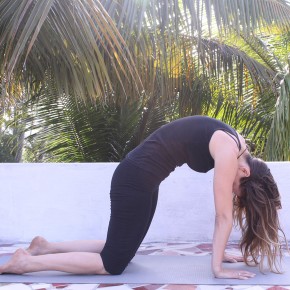The holiday season is but a distant memory, we’re not sure whether Summer really is on the horizon, and we’re only just re-remembering that Spring always dances a merry dance of sunshine and cold, cold rain. At this time of year, we are yearning for stability in our lives even more than usual, and with a grounding Transformational Yoga practice we can find our strength through stillness.
The term grounding means connecting to the earth, and is associated with feelings of balance, centeredness and connection.
For many of us it requires a shift in our thinking mind, as we’ve become used to leading goal-oriented lives: going forward, moving up, growing up, waking up…which we can still be and do, though it’s also important to have strong foundations, healthy roots.
According to the chakra system (energy centres linked to our endocrine system) and in Ayurveda (traditional Indian medicine), “root” issues (like family, security, boundaries and new beginnings) often manifest physically (for instance in the back, legs, feet and bones). To counter these root issues, let’s go outside and relax into nature…
A simple practice
Either standing or sitting, take a minute to ground yourself. Feel the strength and security in your feet, up through your legs and up and outwards across your hips. You are a part of the earth, you are fully supported. Breathe in, grow upwards; breathe out, ground downwards.
Grounding through asanas
  |
Tadasana, or mountain pose, is one of the most balancing poses in yoga. Tada means mountain, and in the pose, your feet are firmly rooted to the ground while the crown of your head acknowledges the sky. While in tadasana, imagine your feet sprouting roots that draw deeply down into the ground.
Benefits: Improves posture // Strengthens thighs, knees, and ankles // Firms abdomen and buttocks // Relieves sciatica // Reduces flat feet |
Virabhadrasana II (Virabhadra = the name of a fierce warrior, an incarnation of Shiva, described as having a thousand heads, a thousand eyes, and a thousand feet, wielding a thousand clubs, and wearing a tiger’s skin), or Warrior II requires concentration and core strength. With an unbalanced muladhara (root) chakra, your fight or flight instinct is activated. Virabhadrasana gives you the strength to face your fears.
Benefits: Strengthens and stretches the legs and ankles // Stretches the groins, chest and lungs, shoulders // Stimulates abdominal organs // Increases stamina // Relieves backaches, especially through second trimester of pregnancy // Therapeutic for carpal tunnel syndrome, flat feet, infertility, osteoporosis, and sciatica |
 |
 |
Uttanasana, or standing forward bend, helps soothe the mind from “monkey mind” or anxious thoughts. Stress and anxiety are hallmarks of unbalanced muladhara (root) chakra. Coupling uttanasana with deep breathing stabilizes and focuses the mind.
Benefits: Calms the brain and helps relieve stress and mild depression // Stimulates the liver and kidneys // Stretches the hamstrings, calves, and hips // Strengthens the thighs and knees // Improves digestion // Helps relieve the symptoms of menopause // Reduces fatigue and anxiety // Relieves headache and insomnia // Therapeutic for asthma, high blood pressure, infertility, osteoporosis, and sinusitis |
Setu Bandha Sarvangasana is bridge pose, another grounding pose that stabilizes the core and deepens as the feet become more firmly rooted in the floor. Setu bandha sarvangasana lifts the spirit with the heart, establishing a bond between our physical, emotional, mental and spiritual bodies.
Benefits: Stretches the chest, neck, and spine // Calms the brain and helps alleviate stress and mild depression // Stimulates abdominal organs, lungs, and thyroid // Rejuvenates tired legs // Improves digestion // Helps relieve the symptoms of menopause // Relieves menstrual discomfort when done supported // Reduces anxiety, fatigue, backache, headache, and insomnia // Therapeutic for asthma, high blood pressure, osteoporosis, and sinusitis |
 
|
Hug a tree
Whether with yoga asanas, a tree visualisation, getting back to nature or by hugging a tree, we can treat our “nature deficit disorder”.
Hug a tree – it’s science, don’t you know?! (Yes you can, no one’s looking. And if they were, they might just want to join in!)
We will be focusing on these grounding asanas in our Transformational Yoga practice, every Wednesday morning and Sunday evening at Brixton BASS. Book onto a new block of 6 classes beginning April 2nd.



























